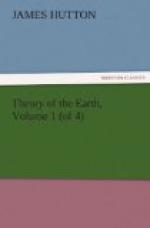He has formed a hypothesis for explaining the general appearance of that which was once the bottom of the sea being now found forming the summits of our mountains; but surely this philosopher will acknowledge, that those natural appearances, in any particular place, will be the same, whether we suppose the bottom of the sea to have been raised, as in the present theory, or the surface of the sea to have sunk according to his hypothesis. For, it is equally easy to suppose a portion of the earth to have been raised all this height, as to suppose all the rest of the surface of the globe to have sunk an equal space, while a small portion of the bottom of the sea, remaining here and there fixed in its place, became the highest portion of the globe. Consequently, whatever evidence this philosopher shall find in support of his theory of the present earth, (a subject which it is not our purpose to examine) it cannot be allowed that he has here brought any argument capable of disproving the elevation of the bottom of the sea; a supposition which other theories may require.
I would now observe, in relation to the present theory, that so far as this author has reasoned justly from natural appearances, his conclusions will be found to confirm the present supposition, that there is to be perceived the distinction of primordial, and that of secondary, in the masses of this earth, without altering the general theory either with respect to the original formation of those masses, or to their posterior production.
Here one of two things must be allowed; either that those strata of schistus had been broken and distorted under a mass of other superincumbent strata; or that those superincumbent strata had been deposited upon the broken and distorted strata at the bottom of the sea. Our author, who has examined the subject, inclines to think, that this last has been the case. If, therefore, strata had been deposited upon broken and bare rocks of schistus, it is probable that these had been sunk in the sea after having been exposed to the atmosphere, and served the purpose of land upon the globe.[31]
[Note 31: This is also supported by another very interesting observation contained in this letter. M. de Luc observes, that in this country the schistus is generally covered by strata of lime-stone, and that these lime-stone strata are again covered with those of sand-stone, in which are found a great many fragments of schistus lying flat. Therefore, while those sand-stone strata were collecting at the bottom of the sea, there had been rocks of schistus in some other place, from whence those fragments bad been detached.]
An example of the same kind also occurs in the Discours sur l’Histoire Naturelle de la Suisse; and this author of the Tableaux de la Suisse has given a very distinct description of that appearance, which is perhaps the more to be valued as a piece of natural history, as this intelligent author does not pretend to any geological theory, but simply narrates what he has seen, with such pertinent observations on the subject as naturally must occur to a thinking person on the spot.—(Discours, etc. page 228. Entree au pays de Grisons).




